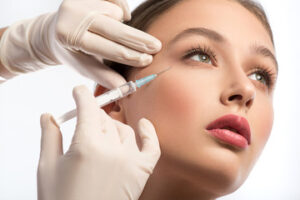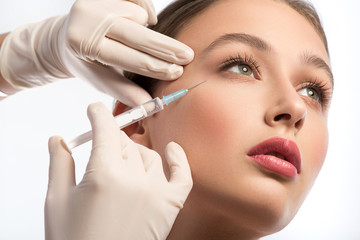Botox is one of the most popular cosmetic enhancement procedures. It’s quick, affordable, and noninvasive. Botox works by temporarily relaxing the muscles that cause wrinkles. It also prevents them from deepening over time. It’s also used to treat medical issues like migraines and excessive sweating. It’s also an excellent option for softening hard lines and creases on the face.
 Face Botox minimizes the appearance of lines and wrinkles by temporarily relaxing muscle activity. It is most effective on dynamic wrinkles created when you smile, frown, or squint. Repeated motions cause the muscles to tighten and create creases in the skin, eventually becoming permanent. While fillers work better on static lines, Botox is a great option for dynamic wrinkles.
Face Botox minimizes the appearance of lines and wrinkles by temporarily relaxing muscle activity. It is most effective on dynamic wrinkles created when you smile, frown, or squint. Repeated motions cause the muscles to tighten and create creases in the skin, eventually becoming permanent. While fillers work better on static lines, Botox is a great option for dynamic wrinkles.
Botox is made from the purified protein botulinum toxin type A and is safe for cosmetic use. It works by blocking nerve signals to contract the muscles, which causes them to relax and soften the lines. It is a minimally invasive procedure and can be performed in a doctor’s office. The injection only takes a few minutes, and the patient doesn’t need any anesthesia. The needle is very thin, so most patients don’t feel pain during the treatment.
Once the Botox is injected, it takes about 24 hours for it to settle into the muscle. During this period, you should avoid facials, massages, scrubs, and any other treatments on the treated area to prevent the toxin from spreading to unintended areas. The effects of the Botox typically last about three to six months.
While there is no definitive answer to the question “Can you get Botox too early?” most dermatologists agree that it is a good idea to start Botox preventatively before getting into the deep creases of age. Your physician can tell whether you are a candidate for preventive Botox by looking at the way your face moves and identifying the areas where you tend to purse your lips or furrow your brow. They can then inject those specific muscles to prevent new lines and wrinkles from forming over time.
Crow’s feet are fine lines and wrinkles that appear at the corners of the eyes. They are caused by repetitive muscle movements, like smiling and squinting. The appearance of these lines is often a sign that you’re older, but they can also be a result of smoking or excessive UV exposure. The good news is that they can be reduced with a Botox injection.
This cosmetic treatment relaxes the muscles that cause dynamic wrinkles and fine lines, like crow’s feet, for a more youthful look. You’ll likely notice results within 24 hours of your procedure, and they will last for about 3 or 4 months before the effect wears off.
During your Botox consultation, you’ll discuss which areas of your face need to be treated. While your practitioner will customize each treatment to your specific needs, the general rule is that the smaller the area being treated, the fewer units of Botox are needed. When treating crow’s feet, the number of units required depends on the depth of the lines and their severity.
While crow’s feet may be an inevitable part of aging, you can help reduce the appearance of these fine lines and wrinkles by eating a healthy diet, exercising regularly, and wearing sunscreen when outdoors. You can also delay the development of these lines by avoiding excess squinting or frowning.
The best way to prevent crow’s feet and other fine lines and wrinkles is by starting a skin rejuvenation regimen early. Many people in their twenties and thirties are now getting preventive facial treatments, including Botox, to reduce the appearance of early fine lines and wrinkles. This allows them to look younger and healthier for longer.
While Botox can be used for all kinds of wrinkles, it’s particularly effective in softening lines around the mouth. As we age, our lips and jawline lose their youthful contours, causing fine lines and wrinkles to appear. Botox can be used to soften these lines, making you look more approachable and friendly. This cosmetic injection can also be used to reduce the appearance of a “gummy smile,” a condition that’s sometimes caused by excess gum tissue.
As a noninvasive, minimally invasive treatment, Botox can be done quickly, with no recovery time needed. During the treatment, a small amount of Botox will be injected into the muscles in the targeted area. A topical anesthetic may be applied to numb the area before the injections, but you should not experience any pain or discomfort during the procedure.
The muscles that are targeted by the Botox will begin to relax and smooth out over time. Depending on the area treated, these results can last 3 to 6 months before muscle activity begins to return and the lines and wrinkles reappear.
While some people worry about getting Botox, this cosmetic injection is safe when performed by a qualified professional. It’s important to visit a doctor who specializes in facial rejuvenation procedures, like a board-certified plastic surgeon or dermatologist. This will ensure you receive the correct dosage and the results you desire.
The most common side effects of Botox are bruising and soreness in the treatment area. You should not rub or massage the treated areas to prevent the Botox from migrating to other muscles. The bruising usually subsides within 24 hours, and the soreness should follow suit. Over-the-counter painkillers can be taken to relieve any discomfort that occurs.
While we’re sure you love laughing, you may not like the creases that appear around your mouth as a result. Known as smile lines or laugh lines, these wrinkles can make you look unhappy and aged. Botox can reduce the appearance of these lines. It works by paralyzing muscles that contract when you frown, squint, or smile. These facial lines are also called dynamic wrinkles. Botox and other injectables that contain purified botulinum toxin have been safely used for decades.
When injected by an experienced doctor, the procedure is not painful. You might feel a slight pressure or pinch, but most patients do not describe the injections as uncomfortable. The treatment itself takes only a few minutes.
The results of a single Botox session typically last about 3 to 6 months. To maintain your youthful look, you’ll need to get regular treatments. If you’re considering smile line treatment, look for a board-certified oculoplastic surgeon who has extensive experience with the treatment. Often, non-medical aestheticians won’t be able to offer this service.
Aside from reducing the appearance of smile lines, botox can help prevent new wrinkles. It can even soften the smoker’s lines. These lines can form when you smoke and are more pronounced in some people than others.
Botox can be combined with dermal fillers to target specific areas of the face and reduce lines and wrinkles that don’t respond to muscle movement. Fillers use hyaluronic acid, a naturally occurring substance that helps the skin retain moisture and add volume.
Face Botox is a cosmetic injection that softens the appearance of fine lines and wrinkles around the mouth for a refreshed appearance. It works by using a purified form of botulinum toxin to prevent muscle movement. While this neuromodulator can be deadly in large amounts, the tiny, regulated doses used for cosmetic purposes have been safe to use for decades.
Botox is one of several types of anti-wrinkle injectables, with other popular options including fillers and Dysport. While both of these treatments can improve the appearance of lines and wrinkles, they aren’t as versatile as Botox. They require more time to recover from and can only reduce the look of superficial lines, while they can’t change the size or shape of your lips.
During the procedure, your provider will clean the area and apply topical numbing cream or ice. Then, they’ll use a narrow needle to inject the Botox into the targeted muscles. You’ll feel a slight prick and tingling sensation. Then, the botulinum toxin will begin to relax the targeted muscles, which stops them from contracting. As a result, the lines and wrinkles will soften or disappear.
Other uses for Botox include reducing neck spasms, excessive sweating (hyperhidrosis), an overactive bladder, and lazy eye (crossed eyes or misaligned eyes). Some people with migraine headaches also benefit from this treatment, which can reduce the frequency of attacks by targeting the muscle that triggers them.
Botox is a minimally invasive treatment that doesn’t require any downtime or recovery. Its muscle-relaxing effects can last up to six months, and regular treatments help them retain their effectiveness. If you’re interested in receiving face Botox to address wrinkles or other facial issues, schedule a consultation with your provider today.
